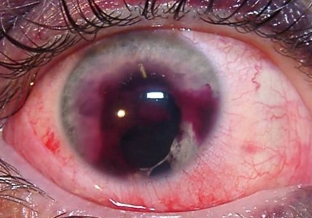Any surgical intervention – it is always a carefully planned and prepared process. Particular attention is paid to preoperative preparation in aesthetic surgery, since the doctor must not only determine the presence of indications and contraindications for surgery in each individual case and plan the intervention itself in stages, but also model the desired final result for the patient. But not always the operation goes as planned, because there is always a certain risk of complications. Erosion of the cornea – this is one of the pathological conditions that can complicate surgical interventions in the periorbital zone.
Characteristic symptoms and treatments for corneal erosion
Cornea or cornea – this is the anterior convex part of the eyeball, which primarily performs protective and light-refracting functions. Erosion of the cornea – This is a disease that occurs as a result of a violation of the integrity of the corneal epithelium. The cause of this condition in most cases is mechanical damage to the cornea by various traumatic agents, so corneal erosion can occur as a result of surgical operations in the eye area. Also, the disease can be & nbsp; the result of degenerative, edematous and inflammatory changes in the cornea.
Corneal erosion:
- Clinical presentation of corneal erosion: corneal syndrome;
- effective treatments for corneal erosion;
- recurrent corneal erosion: treatment features.
Clinical presentation of corneal erosion: corneal syndrome
The clinical picture of corneal erosion is characterized by the appearance of a corneal syndrome, which includes the following symptoms:
- pain in the eyes – associated with the exposure of the nerve endings of the cornea as a result of the erosive process and may turn into a sensation of a foreign body as the damage heals;
- lacrimation and photophobia are the result of irritation of nerve endings and the onset of pain;
- red eyes – this is a reaction of vessels to irritation of nerve endings, but it can also be a sign of an infection;
- vision impairment occurs when the defect is large, as a result of edema of the cornea and a decrease in its transparency.

Effective treatments for corneal erosion
The treatment of corneal erosion is often carried out on an outpatient basis, and is aimed at eliminating the manifestations of the disease and stimulating the reparative processes of the cornea. Local therapy with antibacterial and keratoplastic drugs is carried out:
- to reduce pain – instillation of anesthetics into the eyes;
- for the prevention of inflammatory processes – antibacterial drugs;
- for stimulation of reparative processes - reparants and regenerants;
- general strengthening vitamin therapy.
Restoration of the cornea takes place over several weeks, after which patients are prescribed drugs based on natural tears, as well as agents that improve metabolic processes in the tissues of the eye, which is necessary to prevent recurrence of the disease.
Recurrent corneal erosion: treatment features
Recurrent corneal erosion – This is a dangerous disease that, if not treated effectively, threatens to develop post-traumatic keratitis, followed by their transition to a creeping corneal ulcer. The disease is characterized by a sudden onset with the appearance of vesicles on the cornea and subsequent desquamation of the epithelium. In the clinical picture of recurrent corneal erosion, there is a pronounced corneal syndrome with a strong pain component. Treatment of the disease is aimed at accelerating healing and preventing inflammatory processes. For this purpose, patients are prescribed antibacterial, keratoplastic and non-steroidal anti-inflammatory drugs. With frequent relapses of the disease, it is possible to carry out a layered corneal transplantation.









Add a comment